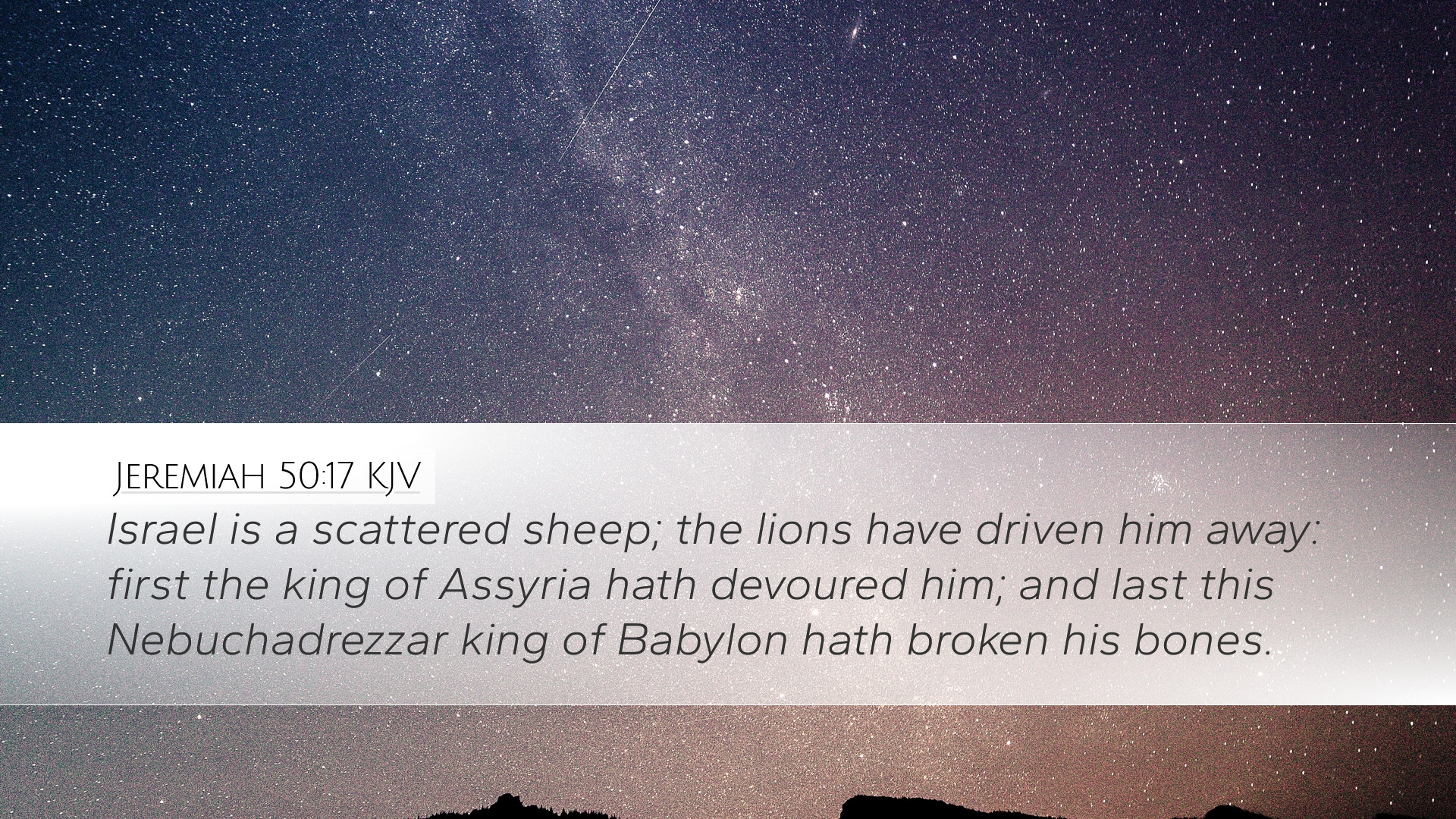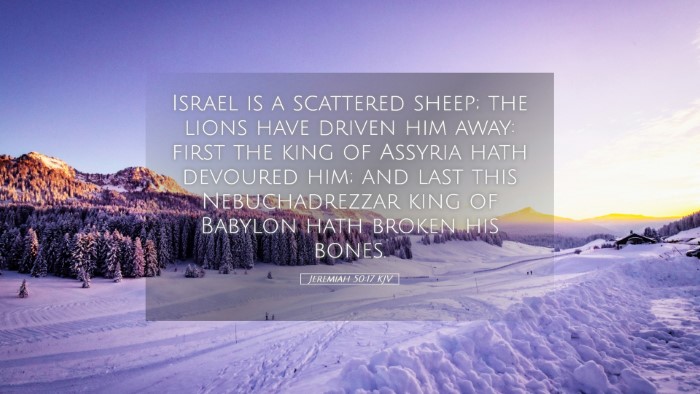Commentary on Jeremiah 50:17
Bible Verse: "Israel is a scattered sheep; the lions have driven him away: first the king of Assyria hath devoured him; and last this Nebuchadrezzar king of Babylon hath broken his bones."
Introduction
This verse finds itself in the context of the prophetic messages concerning the judgment on Babylon and the restoration of Israel. Here, Jeremiah vividly depicts Israel as a sheep that has been scattered and preyed upon by ferocious lions—symbolizing the aggressive nations of Assyria and Babylon. This commentary will collate insights primarily from Matthew Henry, Albert Barnes, and Adam Clarke to elucidate the deeper meaning of this verse.
Contextual Background
Jeremiah, known as the weeping prophet, delivered messages of warning and hope to the people of Israel. The historical context surrounding Jeremiah’s prophecy is significant; after being conquered by Assyria, Israel was vulnerable, leading to further destruction and scattering under Babylonian rule. This verse not only reflects the historical events but also points to the spiritual state of Israel.
Assyria and Babylon as Lions
Both Assyria and Babylon are portrayed as lions in this passage. Matthew Henry points out that these nations acted with ferocity and power, much like lions preying upon their helpless prey. In the ancient Near East, lions were potent symbols of danger and strength, representing the might of the conquering nations.
The Scattering of Israel
Henry further elucidates that the scattering of Israel is not merely a physical dispersion but reflects a spiritual estrangement from God. The metaphor of a sheep scattered by lions speaks to the vulnerability and helplessness of Israel in the face of powerful foes. Albert Barnes notes that this imagery conveys a deep sense of loss and regret over the nation’s inability to defend itself against overwhelming external pressures.
The Role of Assyria and Babylon
The mention of Assyria and Nebuchadnezzar’s Babylon highlights two phases of Israel’s oppression. Clarke emphasizes that Assyria was the initial aggressor, leading to the captivity of the northern kingdom of Israel. Subsequently, Babylon, under Nebuchadnezzar, became the instrument of God’s judgment against Judah. This layered history of oppression enhances the distress conveyed in Jeremiah's words.
The Symbolism of ‘Broken Bones’
The phrase “broken his bones” is particularly poignant. Matthew Henry suggests that this indicates a total dismemberment and failure of strength among the people of Israel. This injury symbolizes not just physical ruin but a deeper, more profound spiritual breaking that results from the nation’s sins and the judgment of God.
Theological Implications
This verse opens discussions on several theological themes:
- The Providence of God: The passage illustrates God's sovereignty in using nations as instruments of judgment. Clarke explains that while God allows Assyria and Babylon to act, His ultimate purpose is to bring about repentance and restoration.
- The Nature of Judgment: Barnes reflects on how God's judgment is both severe and corrective. The scattering serves a purpose; it brings the people to a point of realization regarding their disobedience.
- Hope of Restoration: Despite the grim imagery, there is an underlying hope that emanates from Jeremiah's prophecies. The scattering is not the end, as the eventual restoration of Israel is promised once the exile has fulfilled its purpose.
Pastoral Applications
For pastors and theologians, Jeremiah 50:17 provides profound lessons regarding pastoral care and the need for reconciliation. The imagery of a scattered flock calls attention to the need for church leaders to actively seek after those who have wandered away from the faith, much like a shepherd who seeks out lost sheep. Furthermore:
- Empathy for the Straying: Just as Israel is depicted as helpless and scattered, church leaders are encouraged to approach those who are straying with empathy and love.
- Awareness of External Pressures: Leaders must recognize the external societal and spiritual pressures that can scatter the flock, including cultural influences that lead to disobedience and apathy toward God.
- Hope and Restoration: The promise of restoration is central to pastoral care; it reinforces the belief that no one is beyond the reach of God's redemptive power.
Conclusion
In Jeremiah 50:17, we encounter a vivid metaphor that illustrates Israel's plight under foreign oppression while simultaneously addressing the spiritual crisis of disobedience to God. The combined insights of Matthew Henry, Albert Barnes, and Adam Clarke shed light on the multifaceted nature of this verse, revealing its historical, theological, and pastoral significance. This passage serves as a reminder of both the grave consequences of straying from God and the hopeful promise of restoration for His people.


